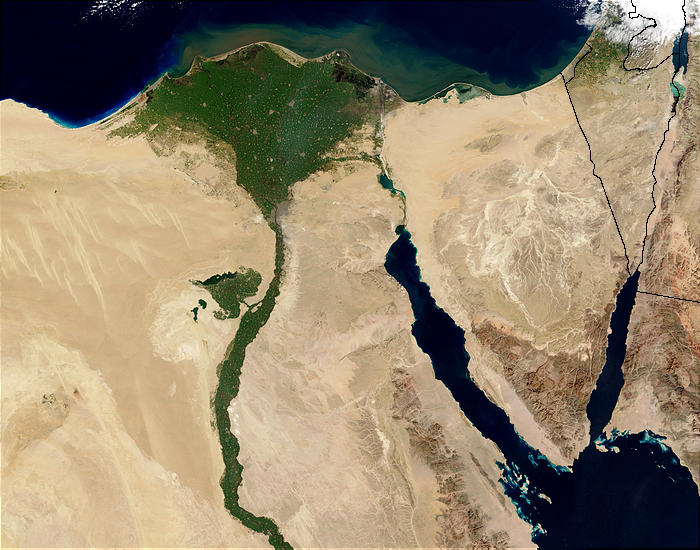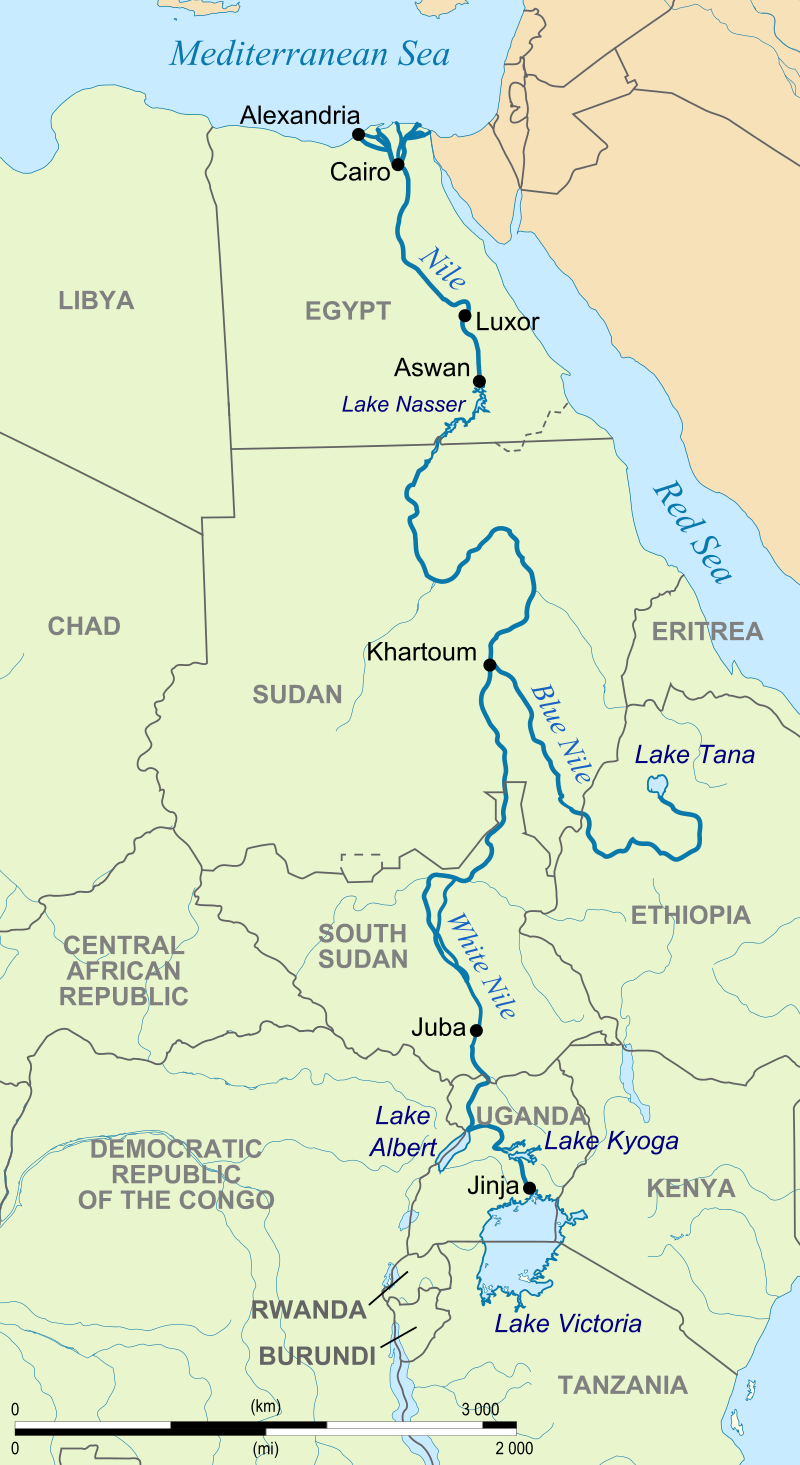The Nile
The Nile is one of the largest rivers in the world, and one of the most well known. Situated in north east Africa, it flows from it's head waters into the south eastern Mediterranean. A couple of early human empires have existed on it's shores in the past, with Egypt being the most well known, and the lesser known Kushite empire to the south being another. It's name is Iteru or Ḥ'pī in Ancient Egyptian. The Nubians also controlled parts and referred to it as Áman Dawū, along with Kiira or Kiyira in the Ganda language of Luganda, while in the Banto language of Runyaru it is Kihirra.
Geography
The Nile is a major river running from it's head waters far to the south starting in what will become Tanzania & Kenya. It's original source is a lake that will eventually be called Lake Victoria of which the White Nile follows out towards the north. After a while, another tributary called the Blue Nile follows into it from a lake that will eventually be called Lake T'ana in Ethiopia, to the east of the main river body. These meet in a country that is referred to as Sudan, of which the old Kushite empire controlled. There it flows into Egypt on its way to the sea.
The lakes and the White & Blue Niles are surrounded by a mix of ecological systems that feed the water into the main body. Much of the land is desert, with silts of different kinds mixing in. Since there is some wildlife these rivers especially when it passes from Lake Victoria, the silts have a major mix of particles of different kinds in it.
The banks of the Nile as a whole is in stark contrast to the surrounding areas, especially in the lower areas. These areas are primarily desert but the banks during the rainy seasons when it floods are rich in mud that helps sustain life.
Ecosystem
The ecosystem is quite different at the lower & upper parts of the Nile, while itself can be quite diverse too. The upper parts hold a large volume of water due to the lakes spilling out down the White Nile, then being topped up by the Blue Nile. Due to the elevation and just being off the equator, the waters are warm and sustains many fish, birds, reptiles, amphibians, and plants. There are some found on down the Nile, but usually more marine animals, or those willing to take advantage of different conditions. When the Nile hits the parts in the old Nubian area onwards through Egypt, there is more desert beyond the flood plains surrounding the banks. Since it passes the equator here, it can also be hotter.
Ecosystem Cycles
Equatorial conditions apply here to the Nile since it flows through it. As a river that flows through one of the larger deserts of the world as well, it experiences Spring and Summer. No autumn or Winter is ever experienced, and during the middle of Summer it can experience a large drop in volume with roasting hot days & extreme temperature drops at night. At the same time, in early & middle Spring time it can suffer from heavy rains at its head waters leading to flooding in many areas including as far as Egypt.
Localized Phenomena
Regular flooding of the Nile happens usually in Spring, allowing for mud & silt built up in the river to spill out over it's banks & fertilise the surrounding terrain. This happens at least once a year.
Nearby, there are ancient Egyptian cities, temples & graves. Most seem to be empty, and that couldn't be further from the truth. Undead, Jinn, Demons / Devils, and the odd bandit group can be found in many. Curses are present in some, and this is obviously used to protect the dead.
Fauna & Flora
Electric catfish, Nile tilapia, lung fish & marbled lung fish, Nile perch, tiger fish, vundu, mud fish, and hydrocynus vittatus are common fish found in the Nile. Crocodiles are found in parts and the Nile Crocodile in the lower Nile is one of the most feared animals there. Also, hippopotamus are too and known to be very aggressive. Nile monitor lizards are found in parts along the banks, and Nile Cobras & African rock pythons are common, hunting small prey animals. Africa softshell turtles are found making use of the waterways too. Egyptian geese, Ibis, and African sacred Ibis are common birds too. Sometimes dice snakes are encountered as well as the African common toad are other species too. Live stock such as African oxen, goats, and sheep are found as well.
Wheat, barley, and grapes are common agricultural plants that are grown, as well as reeds that naturally occurring too. Reed mace ambatch, Tall bamboo -like grasses, turor, and water lettuce is found growing along the banks. Palm trees are common, along with Citrus, Fig, and Mango trees. Also, Rose Poinciana, Lotus, Jasmine, Lily, Bird of Paradise, and sunflower plants can also be found. Sometimes Onions, Garlic, and Lentils can be grown by farmers too.
Natural Resources
Fishing and agriculture are the main natural resources that have been used for centuries on the Nile. It also allows for travel up and down certain lengths of it that helps transport goods. Reeds are harvested, including natural reeds, and turned into papyrus.
Sometimes marble & sandstone are quarried & transported down the Nile.
History
The Nile has been used by many species over the millennia of it's existence. As a freshwater source & having plants & animals living in & around it, it has been travelled extensively. Also, many empires have used it over time. The most well-known has been the Ancient Egyptian & Kushite empires in human history.
Some scholars have found earlier societies have also used the Nile. One in particular has been tied in with the river, and that is the Yuan-Ti. They have used it extensively before Humanity ever walked out of central & southern Africa. They travelled as far as the Mediterranean & back. Ancient structures are rumoured to lie in the deep desert of the Sahara, with most being in & around the Nile. Many of these are found dotted in hidden regions along the whole river.
What happened to the Yuan-Ti in this part of Africa is unknown, and there is likely still hidden cells of the species there.
As for the Nile itself, it was formed over millions of years, with water slowly draining down over time. What happened was that after the last major ice age was the waters were able to eventually drain down the present route, leading to the formation of the river proper.
"A river like I've never seen before, the Nile that is. So wide, so deep. Life seems to bloom all around it, and then you look further, seeing only desert. Boats can be seen when around civilisation bringing food, or other goods back & forth. Ancient ruins dot parts of these banks showing how much history is here.
That's not the thing I want to mention. It's the heat & the wildlife. If your not careful, the heat or the animals will get you. It's almost as if the Nile is out to get you. The snakes are deadly, the fish strange, but the worst is the Nile Crocodile. A massive creature, it lies in wait, just showing enough to look like a log floating on the river's surface. Then when animals try to cross or drink (oh gods, you gotta drink there, the heat), it rises to snap it's jaws down on it's prey. Seen it happen the once, and kept back from the edge ever since. It got a worker repairing a berth on a town's docks. Bloody water everywhere!! Scared me indeed."
Volo, on Travelling to the New World.
Type
River




Comments